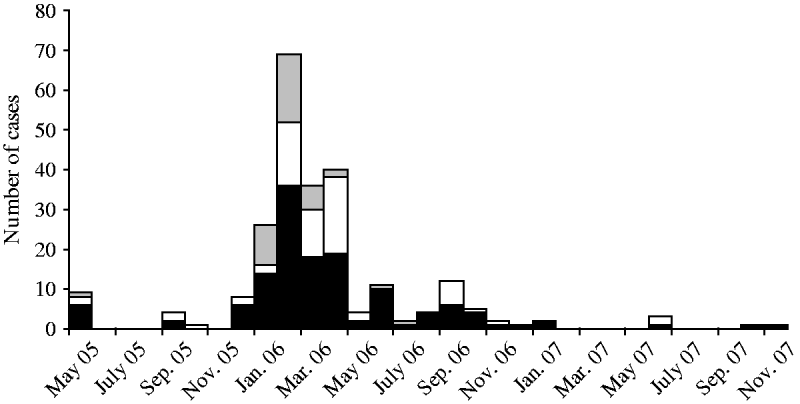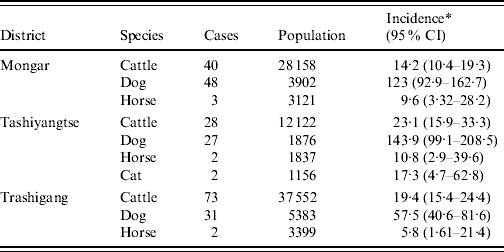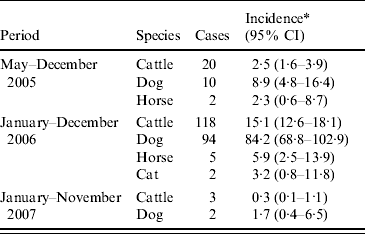Rabies is an acute viral disease transmitted by the bite of a rabid animal. Each year, about 55 000 people die of rabies in Asia and Africa, mainly because of endemic canine rabies [Reference Knobel1]. In Asia, a large number of human rabies deaths occur in India, and a national multi-centre epidemiological survey has estimated an annual burden of about 20 000 human deaths due to rabies in India [Reference Sudarshan2]. Rabies has also been described as a re-emerging problem in China, with about 2000 human deaths reported annually [Reference Sudarshan2–Reference Wu4].
Bhutan is a small Himalayan kingdom situated in South Asia in between India and China. Until the early 1990s, rabies in dogs and other domestic animals was reported from most parts of Bhutan. A national rabies control programme – vaccination of dogs (both free-roaming and pet dogs), implemented in 1992 – controlled or eliminated canine rabies from the interior part of the country [Reference Owoyele5, 6]. Since then, canine rabies has been endemic only in areas of southern Bhutan that share the porous border with India. Domestic dogs are the main reservoir of rabies in Bhutan, with spillover infection to other domestic animals, especially cattle. However, the reported incidence of rabies in humans is low and only sporadic cases occur in Bhutan [7].
Rabies is a notifiable disease in Bhutan and it is mandatory to report even suspected cases [8]. A thorough investigation is undertaken in the event of a suspected outbreak in animals. A fluorescent antibody test (FAT) – which is recommended by both the WHO and World Animal Health Association (OIE) – is used to confirm rabies in animals [Reference Dean, Abelseth, Atanasiu, Meslin, Kaplan and Koprowski9–Reference Fooks11]. The epidemiological data are collected and stored in the Veterinary Information System (VIS) database. As a control programme, vaccination and sterilization of dogs are conducted annually in the country focusing mostly on towns that have high, free-roaming dog densities. However, the programme coverage has been low (<20%) because of limited financial resources and the high population turnover in the free-roaming dog population [6].
In this report, we describe an outbreak of rabies in dogs and other domestic animals that occurred in the three eastern districts (Tashiyangtse, Trashigang, Mongar) of Bhutan (Fig. 1 a). Since the early 1990s, the villages and towns in these districts had been free from canine rabies and no wildlife-mediated rabies had ever been reported or confirmed in this region or elsewhere in Bhutan. However, between 2005 and 2007, rabies cases were reported in the region and therefore an outbreak was declared.

Fig. 1. Map of South East Asia with an administrative map of Bhutan and the three eastern districts shaded; (a) inset. The monthly report and spread of rabies cases in each sub-district of eastern Bhutan between May 2005 and November 2007 is shown. (b) May 2005 to October 2005 [the index case (•) is indicated]. (c) November 2005 to April 2006. (d) May 2006 to October 2006. (e) November 2006 to April 2007. (f) May 2007 to November 2007 (the last case was reported in November 2007).
On 2 May 2005, the first case suggestive of rabies was reported in a cow at Gongza village, Toetsho sub-district within Tashiyangtse district, located adjacent to the villages of Tawang district, Arunachal Pradesh state, India (see Fig. 1 b). Earlier, a suspected rabid, stray dog was sighted around a cattle herd but could not be traced subsequently. Following this incident, dog-bite cases in cattle and horses were reported in the adjacent villages of the index case. By September 2005, the disease apparently spread into the urban centres and villages of Trashigang district, located about 30 km to the south of the index case (see Fig. 1) and then further spread into the villages and towns of five sub-districts of Mongar district, located next to Trashigang. There was a chain of spread from Tashiyangtse to Trashigang and then to Mongar districts. Epidemiological investigation and the typical clinical signs manifested by affected animals led to suspicion of rabies which was later confirmed by laboratory testing. Of the 51 brain samples (40 cattle, 11 dog) collected from the carcases in the affected villages, 36 (70%) samples (30 cattle, 6 dog) were confirmed to be rabies virus positive by FAT. Samples from all suspected cases were not collected due to logistics and to avoid accidental rabies virus exposure of the people handling carcases during sample collection. When one or more samples from the infected areas were confirmed to be positive, other suspected cases showing similar clinical signs were diagnosed as rabies. Observations suggested an incursion of rabies virus and subsequent local diffusion through the susceptible dog population, with spillover over particularly to cattle.
The epidemiological data – day, month and year of occurrence; species of animals affected (cattle, horses, dogs, cats); and location (village, sub-district, district) of outbreaks were acquired. An epidemic curve was constructed for the whole study region by counting the total number of cases reported per month between May 2005 and November 2007, with the number of cases on the y-axis and the month on the x-axis. The cumulative incidence of rabies was calculated as the proportion of the population at risk that were diagnosed as rabies between 2005 and 2007. The animal census data of 2005 was used as the denominator to calculate the incidence risk for cattle, horses and cats. Since accurate dog population data for the sub-districts of the three districts were not available, we estimated the dog population based on the mean sub-district human population using ratios proposed and validated by Knobel et al. [Reference Knobel1] in Asia, namely 9·5 humans to one dog (95% CI 4·5:1–14·6:1). These authors calculated the ratios based on the available published reports of field surveys conducted in many Asian countries. The estimated dog population was then used to calculate the cumulative incidence of rabies in dogs. A Geographical Information System (ArcGIS 9.3. ESRI) was used to map and visualize the monthly reports and the spread of rabies in eastern Bhutan.
A total of 256 animal deaths [141 cattle, 106 dogs (38 pets, 68 free-roaming), seven horses and two cats] were reported between May 2005 and November 2007. Table 1 shows the cumulative incidence of rabies in cattle, dogs, horses and cats in the three districts. The animal pattern showed a much higher incidence risk in dogs compared to other species of animals. The yearly species-specific incidence risk of rabies showed higher risk in all species of animals during 2006 than in 2005 and 2007 (Table 2) indicating increased transmission of infection during 2006. This is also evident from the epidemic curve (Fig. 2). Only one human death was reported during this epidemic, which accounted for 0·94 deaths/100 000 population at risk in the three districts. About 900 people were potentially exposed to rabies during the epidemic and they received 5–6 doses (Essen regimen) of rabies vaccination from the hospital. The maximum exposures were reported during 2006. The majority of these people consumed dairy products from a suspected rabid cow or handled carcases of animals that died of rabies. However, it is not known how many of these people had actually been bitten by confirmed rabid dogs.

Fig. 2. Epidemic curve of rabies cases in dogs and cattle in eastern Bhutan reported between May 2005 and November 2007. Cases in horses (n=7) and cats (n=2) are not shown because of the low numbers. ▪, Cattle; □, free-roaming dogs; ![]() , pet dogs.
, pet dogs.
Table 1. Cumulative incidence of rabies from May 2005 to November 2007, stratified by species and district, eastern Bhutan

CI, Confidence interval.
* Cumulative incidence, cases per 10 000 population at risk.
Table 2. Cumulative incidence of rabies between May 2005 and November 2007, stratified by year and species in the eastern region of Bhutan

CI, Confidence interval.
* Cumulative incidence, cases per 10 000 population at risk.
Figure 1 shows the monthly reports and spread of rabies in eastern Bhutan between May 2005 and November 2007. There was a rapid spread between January and April 2006 and a large number of sub-districts were affected during this period (Fig. 1 c). Some sub-districts reported persistence of infection for a longer period of time than other sub-districts. The rabies outbreak was eventually confirmed in 18 (45%) of the 40 sub-districts affecting 6/8, 7/15 and 5/17 sub-districts in Tashiyangtse, Trashigang and Mongar districts, respectively. The proportion of sub-districts that reported rabies from May 2005 to December 2005, January 2006 to December 2006, and January 2007 to November 2007 were 15%, 35% and 7%, respectively. Both dog and cattle rabies was reported in all the sub-districts and almost at the same time, suggesting the role of dog bite in the transmission of disease to cattle (Fig. 2). The source of the disease could not be established, although it is likely to have spread from across the border, since a rabies outbreak in dogs had been reported in Tawang during this period (N. S. Tamang, personnel communication).
The movement of infected free-roaming dogs is believed to have been responsible for the spread of infection in the region. The presence of a road network and the clustered settlement of villages and towns within the region could have facilitated the inter-mixing of dogs between the infected and non-infected areas resulting in rapid spread and persistence of infection. However, landscape features such as mountains and rivers may have been physical barriers to the further movement of dogs and prevented spread into other areas in the region. For example some villages/sub-districts, although located close to infected villages, did not report rabies because they are separated by a major river.
A series of measures were taken to control the outbreak. A public awareness programme was conducted during 2005 and 2006, when the outbreak was ongoing. Consultative meetings and discussions were held with farmers and village leaders to manage the outbreak. About 5000 dogs (both pets and free-roaming dogs) in the region were vaccinated against rabies. In addition, about 900 free-roaming dogs were caught and impounded in 12 temporary shelters constructed in the three districts. Impounding was done during March and April, 2006 in an attempt to prevent the spread of disease by the movement of free-roaming dogs. They were kept for about 4 months in the shelters and were released in the vicinity of capture after vaccination and sterilization. Although impounding is not a recommended strategy for the control of rabies, it was used during this outbreak as an alternative measure to mass culling of dogs, in response to the religious (Buddhist) sentiment of people in the community. No rabies cases were reported or confirmed in the dogs in the shelters. Further studies are necessary to determine the beneficial or deleterious effects of impounding dogs during an outbreak. Although mass culling of free-roaming dogs was not implemented during this outbreak, rabid and some in-contact dogs were eliminated after people realized the seriousness of the disease (many people had lost their valuable animals because of rabies). Such restricted culling may have removed the reservoir of infection resulting in fade-out of the epidemic. A similar major rabies epidemic that occurred in Chukha district in the southwestern part of Bhutan between January and July 2008 was controlled by immediate culling of in-contact free-roaming dogs in the outbreak areas. This outbreak affected three sub-districts and resulted in the death of 42 cattle, 52 dogs and three horses. Another rabies outbreak that occurred during 2008 in Samtse district – which is located adjacent to Chukha district (Fig. 1 a) – was also controlled by immediate culling of in-contact free-roaming dogs in the outbreak areas.
The experiences and the review of this epidemic suggest either the lack of a clear rabies outbreak control strategy for a major outbreak or the failure to implement the strategy in eastern Bhutan. Effective control of any disease depends on clear policy guidelines and their implementation, with legal support as well as effective communication. Therefore, control of any rabies outbreak in the future should be aimed at eliminating the reservoir of infection by immediate culling of in-contact and unvaccinated free-roaming dogs in the outbreak areas. An awareness programme on the public health importance of rabies is also necessary to promote good community participation in the control programme. As a preventive measure, sustained sterilization and vaccination of dogs with >70% coverage would induce herd immunity and eliminate rabies in canines [12]. In addition, dog population management should be targeted towards habitat control by proper waste management and promoting a sense of responsible dog ownership in the community. Blanket mass culling or removal of dogs may not be a practical solution since it will be neither acceptable to the community (as evidenced from this outbreak) nor scientifically justifiable. We also recommend that the collection of good quality epidemiological data such as estimates of the dog population, combined with laboratory surveillance, would provide accurate information for the planning and management of rabies in Bhutan. In this report, the risk estimates in dogs could be biased due to errors in estimating the population at risk in the region or inclusion of non-rabies cases in the data. Therefore, attempts should be made to collect all suspected samples in any future outbreak for laboratory confirmation of the cases. In addition, since no genetic characterization was done during this outbreak, it is also important to study phylogenetic relationships in order to understand rabies virus variants circulating in Bhutan.
The analyses presented in this report are descriptive and provide a basis for further analytical investigations to explain the evolution of the epidemic and generate hypotheses for the spread of rabies in eastern Bhutan.
ACKNOWLEDGEMENTS
We thank the livestock field staff of Trashiyangtse, Trashigang and Mongar districts and the staff of the Regional Veterinary Laboratory, Khaling for their support during the time of investigation and for the field data.
DECLARATION OF INTEREST
None.






